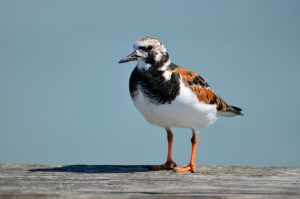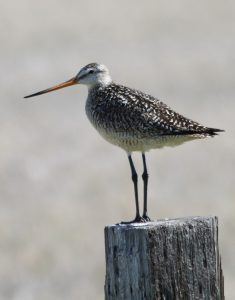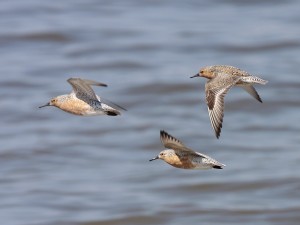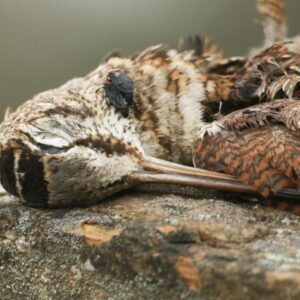Collaborating on bird conservation with the Moose Cree First Nation along James Bay

Ted Cheskey
Senior Conservation Manager – Bird Conservation, Education & Networks
Ted leads Nature Canada’s domestic and international bird conservation initiatives and the Nature Caretakers program.
Earlier this year, Nature Canada’s Ted Cheskey took a trip to Moose Factory near James Bay where he met with several members of the Moose Cree First Nation (MCFN) about officially nominating the James Bay coastal zone within the MCRN homelands as a Western Hemisphere Shorebird Reserve Network (WHSRN) site. We spoke with him about his trip and the work he has been doing on this project.

Ruddy Turnstone
Tell us a little about your trip to James Bay.
Ted Cheskey: It was really quite exciting, even starting with the plane ride! I was leaving from the Pierre Elliot Trudeau airport in Montreal on a flight scheduled at 6 am and, of all the days, there was a huge blizzard that morning. Flights were cancelled and delayed and, though I eventually made it to Moose Factory in one piece, it was a fairly eventful start to the trip. A fun memory was spotting a Snowy Owl (Quebec’s provincial bird) sitting on a light beacon during the blizzard as we were waiting for deicing on the runway.
Once there, the project I’ve been working on for the past couple of years with MCFN made some good progress and the trip, overall, was quite productive.
What project have you been working on?
TC: We have been supporting MCFN in the process of nominating a site for WHSRN consideration.

Marbled Godwit
WHSRN – pronounced “wizern”– is a conservation strategy that came about in the 1980s. Their focus is on shorebird conservation, shorebirds referring to a large group of similar birds mainly belonging to the Scolopacidae, or sandpiper family and the Charadriidae, or plover family.
The MCFN has a strong interest in bird conservation and the location is a prime candidate as a WHSRN site as it supports tens of thousands of shorebirds every year, including significant portions of the global population of several species such as the Rufa Red Knot, Hudsonian Godwit, Semipalmated Sandpiper and White-rumped Sandpiper. Shorebird researchers have been studying this area for decades, but it has only been in the last few years that MCFN community members have become engaged with the shorebird research and have acknowledged the significance of this site for shorebirds, as well as becoming aware of the WHSRN program.
Since WHSRN nominations must come from the site “owner,” in the broadest sense of the term, it was an excellent opportunity for collaboration. As a result, we’ve been helping partners and colleagues from the MCFN with the process of getting the required support and with the work required to move the nomination along, which includes compiling data and filling out the necessary paperwork. Working with MCFN is always an education for me – especially around the value and importance they ascribe to community involvement in decision making. We have much to learn in the south.
Why is the James Bay area so important for shorebirds?
TC: In Canada, we have many shorebirds that breed in the arctic and subarctic. These birds are dependent on very specific sites, both for breeding and as stopover locations on their lengthy migrations. In fact, their overall migrations are singularly long, with some species travelling from the arctic all the way to the tip of South America (though not all at once). Being so location dependent, these species are vulnerable to habitat losses from a variety of causes, which is why it is so important to protect these spaces. If they use, say, five key sites along a migration route of 10,000 km, you can imagine how disastrous it would be should one of these sites become unsuitable due to habitat destruction, an oil spill, or something else.
Currently, there are seven WHSRN areas in Canada: the Bay of Fundy, one on the coast of British Columbia, and the rest are in the prairies. The addition of this site would make the eighth. WHSRN has nearly 100 sites overall but there is a grievous lack of sites in the northern region, which is why we are happy to see the James Bay area nominated.

Red Knots in flight
How did this whole enterprise come about?
TC: The MCFN are very interested in having healthy bird populations in their homelands as birds (mainly geese and ducks) are staples in their diet. They also know that a healthy ecosystem is good for them and good for other wildlife. Our collaboration began around Important Bird and Biodiversity Area (IBA) conservation nearly 18 years ago when I first visited Moose Factory and met Lillian Trapper, an extraordinary person who, at the time, was leading their land use planning efforts.
In 2011, I had the great pleasure of accompanying Lilian to the 25th Anniversary celebration of WHSRN. There were many excellent speeches made throughout the event, and Lillian herself spoke about bird conservation from her and the MCFN’s perspective. Her speech was very well received – I think people were really interested in her unique view. You could say this is where the seeds of the WHSRN idea were sown.
Two years ago, with the support of federal government funding, Nature Canada and MCFN convened a meeting including other stakeholders to combine the seven IBAs along the coastline of James Bay within the MCFN homelands into one giant one that also captured all of the important habitats for shorebirds, waterfowl and other species of interest. At the time, we talked about how this “super IBA” could be the core of Canada’s next WHSRN site. The rest now seems like history!
Thanks to a grant from Arctic Migratory Birds Initiative (AMBI) – a project from the Commission for Environmental Cooperation (CEC) – we were able to organize another meeting in Timmins, ON in May 2016.
All in all, we are very happy with the work that was put into this project. It has been a great collaborative effort and it’s always a pleasure to see communities get involved and take conservation into their own hands!



